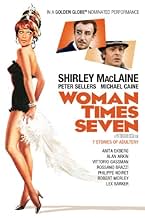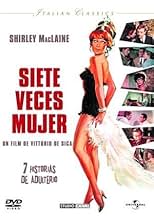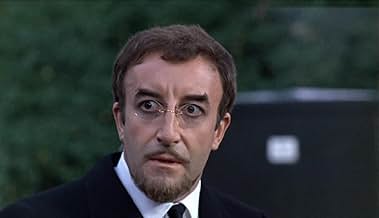IMDb RATING
5.8/10
2.1K
YOUR RATING
Seven portraits of different types of women.Seven portraits of different types of women.Seven portraits of different types of women.
- Awards
- 1 nomination total
- Director
- Writer
- All cast & crew
- Production, box office & more at IMDbPro
Featured reviews
There are two types of movies that came out of the 1960s: strange, experimental films and lusciously colored films that made later generations ask, "Were the sixties really like that?" Woman Times Seven is a mixture of both, which would be a reason to watch it, if you're interested in different types of classic films. The movie has beautiful costumes, lavish colors, and oddly 60s music; and at the same time, it's strange and experimental. Seven completely unrelated short stories—each about infidelity—are played out, all starring Shirley MacLaine! She really is darling, so if you want to see her in various wigs and furs, and with beautiful expressions from heavily made up eyes, you won't want to miss this one.
The vignettes themselves aren't really all that good. Shirley has several different costars, including Peter Sellars, Alan Arkin, Rossano Brazzi, and Michael Caine. But the plots vary from silly to stalker-y to sad. It's not the best movie out there, but it won't hurt you if you want to see pretty people up on the screen.
The vignettes themselves aren't really all that good. Shirley has several different costars, including Peter Sellars, Alan Arkin, Rossano Brazzi, and Michael Caine. But the plots vary from silly to stalker-y to sad. It's not the best movie out there, but it won't hurt you if you want to see pretty people up on the screen.
Shirley MacLaine playing seven different women in seven short stories directed by Vittorio De Sica about male-female relationships. Putting indefatigable Shirley in a variety of wigs and costumes opposite a host of male and female stars in guest cameos probably sounded foolproof, but the movie progressively loses steam after its opening episode at a funeral (and the whole idea reminds one of MacLaine's "What a Way to Go!" besides). Alan Arkin, Rossano Brazzi, Shirley's "Gambit" co-star Michael Caine, Elsa Martinelli, Anita Ekberg, Vittorio Gassman and a pre-"Being There" Peter Sellers offer some cute bits and pieces, but this isn't the comedic tour-de-force MacLaine's fans were hoping for. US-French-Italian co-production doesn't look terribly good, while director De Sica's work is scattershot. ** from ****
Shirley MacLaine's performance, interpreting 7 women as different as it can be, is quite breathtaking. The quality of the mini-stories is uneven, some have aged rather badly in my opinion: Funeral Possession, Super Simone and Suicides. Others still provide a real entertainment and great fun: At the opera, Amateur night, and especially the last one, Snow, also starring Michael Caine, with a quite magical and fairy atmosphere. This was clearly the best part!
With so many great talents on screen, I expected a little more from Vittorio de Sica, a director I appreciate very much. Besides MacLaine and Caine, we find indeed a rather exceptional cast with Peter Sellers, Elsa Martinelli, Vittorio Gasman, Anita Ekberg, Philippe Noiret. Unfortunately, the format of 7 vignettes and the rather thin scenarios do not allow these great talents to express themselves as they should.
The movie would have been much better with 3 or 4 mini-stories, not more. De Sica took an evident pleasure in lining up the stars like pearls on a necklace, and Shirley MacLaine obviously enjoyed herself in this collection of roles, dresses and wigs. But the end result is still a bit meager.
This film was for me like an appetizer buffet, pretty to watch, sometimes fun to taste, but in the end you still fell hungry about something more substantial...
A film directed by the great Vittorio de Sica with Shirley MacLaine! How exciting I thought. Then, every episode has Shirley with a different leading man, Peter Sellers, Alan Arkin, Michael Caine, Vittorio Gassman, Rossano Brazzi, etc, etc. Well, it was too good to be true. The stories are slight and I kept waiting for a bit of ooph. Okay, no. No oomph really but it has moments. Michael Caine and Shirley in a moving comedy of errors for instance and it has her, Shirley MacLaine and that in itself makes it a must because she'll be there for us , seven times, one hundred per cent.
Woman Times Seven is a collection of vignettes about seven random women (not adultery, as the synopsis claims) all played by Shirley MacLaine, and all the women are different. That's the whole point, they are different - one is shy, one is a prude, one is a bitch, one is even boring! They end up in different situations, some ridiculous, some poignant. There is no over-arching thread or moral to bind them together. They are character studies more than plots, something American audiences may not appreciate. Some vignettes are left unresolved, some are broad comedies, some are bittersweet. If you are waiting for the punchline it isn't always here, but sometimes it is, leaving the overall flow bumpy and uneven.
I'm not a fan of vignette films, but it's so difficult to find interesting female characters in today's films. How refreshing to see many different "types" here - even if all played by the same actress. MacLaine is good. She's thoughtful about each character and steps out of her usual pixie/harlot role, but taken together it feels like a gimmick - the sum is not greater than the parts. The characters suit the style of each story, so some have gravity and others are comic caricatures that serve the situation - another aspect that makes the film seem uneven. Within each vignette MacLaine does a fine job, using her considerable talents as a dancer to physically embody each woman differently, but we're not with these women long enough to see any metamorphosis.
The first is a grieving widow opposite Peter Sellers whose words of comfort keep turning to inappropriate propositions. The scene belongs completely to Sellers, and it's the weakest of the stories.
The second character is a prudish wife who after discovering her husband and her best friend in bed, runs out of the house vowing to have sex with the first random man she meets. Instead she finds sympathy in a group of prostitutes who exchange war stories about love and men. For all their sexual experience they don't seem to have a better grasp on relationships, and an instant sisterhood bridges their social divide.
The third is a modern sex farce about a beautiful UN translator who has become so jaded about men that she has idolized her platonic relationship with a gay roommate. Meanwhile she reads poetry in the nude and invites two playboy dignitaries to her bed while she shows them slides of modernist paintings. the handsome men humor her bizarre quirks while trying to get the other to leave, a testament to men putting up with any amount of femcrazy to get laid.
The fourth character is the dull housewife who feels she must compete with the unrealistic fantasy woman of her husband's novels. She begins to embody the outlandish descriptions, wearing wigs and costumes, laughing and singing and being so impetuous that everyone begins to think she is having a mental breakdown. This is the first episode that feels like a real story arc, moving from awkward comedy to a heartbreaking moment as she realizes she has gone too far, crying out "I'm not crazy , I'm just in love!"
The fifth vignette is my favorite. MacLaine plays a society bitch who is mortified to discover a rival will be wearing the same gown to the opera. The stakes escalate as their powerful husbands get involved, then their husbands' corporations as the two Dames flex their power, neither willing to budge. MacLaine is spectacular shifting gears between barking orders at her husband's employees, giving condescending lectures to the maid, looking absolutely fabulous, while plotting violent sabotage. It's lavish and campy and evil. So much fun!
The next episode clunks. MacLaine and Alan Arkin are lovers trying to negotiate a suicide pact but keep coming up with excuses to not go through with it. The dialog feels improv, and it all takes place in realtime in one room, like a one-act play or a TV skit. It's a case where the vignette before it is so lavish and fun this scene drags in comparison.
In the final piece, a shy housewife and a glamorous model friend meet for lunch and they are followed by a young man. As they separate the shy woman is thrilled the man follows her instead of her friend. She wanders home slowly hoping to make the moment last. The tone is innocent and bittersweet (but also a little creepy by today's standards of harassment and stalking - there is a twist at the end that lets us know he will not come back later, break into her house, and murder them all).
What's remarkable with Woman Times Seven is individual moments that stick with you long after the movie has gone. It never gels together as a whole, but I feel that's a problem with all vignette films. There are some interesting situations and characters who probably are not compelling enough for a whole movie, and maybe that's the idea. Most of these women are having small personal moments that define them. It's individual portraits done in a charming way, with a big talent Hollywood actress but with European flavor. We get to follow some pre-feminist characters we would not normally be allowed to see. They are fallible, self-contradictory, and immature.
While there are observations about the different sexual expectations of men and women, it's dismissive to say this is a movie about "adultery" or sexual romps, as if it is another slice of '60s Euro-erotica. Instead of cheesecake, many of the women are portrayed unflatteringly or for laughs. The viewer sees through the illusion they do not see themselves, and there-in lies the opportunity to say dozens of small truths through comedy: it *is* crazy to try to become someone's fantasy. The shyest person could crave dangerous attention. Love is NOT worth dying over, but also death is not the end of love....
I'm not a fan of vignette films, but it's so difficult to find interesting female characters in today's films. How refreshing to see many different "types" here - even if all played by the same actress. MacLaine is good. She's thoughtful about each character and steps out of her usual pixie/harlot role, but taken together it feels like a gimmick - the sum is not greater than the parts. The characters suit the style of each story, so some have gravity and others are comic caricatures that serve the situation - another aspect that makes the film seem uneven. Within each vignette MacLaine does a fine job, using her considerable talents as a dancer to physically embody each woman differently, but we're not with these women long enough to see any metamorphosis.
The first is a grieving widow opposite Peter Sellers whose words of comfort keep turning to inappropriate propositions. The scene belongs completely to Sellers, and it's the weakest of the stories.
The second character is a prudish wife who after discovering her husband and her best friend in bed, runs out of the house vowing to have sex with the first random man she meets. Instead she finds sympathy in a group of prostitutes who exchange war stories about love and men. For all their sexual experience they don't seem to have a better grasp on relationships, and an instant sisterhood bridges their social divide.
The third is a modern sex farce about a beautiful UN translator who has become so jaded about men that she has idolized her platonic relationship with a gay roommate. Meanwhile she reads poetry in the nude and invites two playboy dignitaries to her bed while she shows them slides of modernist paintings. the handsome men humor her bizarre quirks while trying to get the other to leave, a testament to men putting up with any amount of femcrazy to get laid.
The fourth character is the dull housewife who feels she must compete with the unrealistic fantasy woman of her husband's novels. She begins to embody the outlandish descriptions, wearing wigs and costumes, laughing and singing and being so impetuous that everyone begins to think she is having a mental breakdown. This is the first episode that feels like a real story arc, moving from awkward comedy to a heartbreaking moment as she realizes she has gone too far, crying out "I'm not crazy , I'm just in love!"
The fifth vignette is my favorite. MacLaine plays a society bitch who is mortified to discover a rival will be wearing the same gown to the opera. The stakes escalate as their powerful husbands get involved, then their husbands' corporations as the two Dames flex their power, neither willing to budge. MacLaine is spectacular shifting gears between barking orders at her husband's employees, giving condescending lectures to the maid, looking absolutely fabulous, while plotting violent sabotage. It's lavish and campy and evil. So much fun!
The next episode clunks. MacLaine and Alan Arkin are lovers trying to negotiate a suicide pact but keep coming up with excuses to not go through with it. The dialog feels improv, and it all takes place in realtime in one room, like a one-act play or a TV skit. It's a case where the vignette before it is so lavish and fun this scene drags in comparison.
In the final piece, a shy housewife and a glamorous model friend meet for lunch and they are followed by a young man. As they separate the shy woman is thrilled the man follows her instead of her friend. She wanders home slowly hoping to make the moment last. The tone is innocent and bittersweet (but also a little creepy by today's standards of harassment and stalking - there is a twist at the end that lets us know he will not come back later, break into her house, and murder them all).
What's remarkable with Woman Times Seven is individual moments that stick with you long after the movie has gone. It never gels together as a whole, but I feel that's a problem with all vignette films. There are some interesting situations and characters who probably are not compelling enough for a whole movie, and maybe that's the idea. Most of these women are having small personal moments that define them. It's individual portraits done in a charming way, with a big talent Hollywood actress but with European flavor. We get to follow some pre-feminist characters we would not normally be allowed to see. They are fallible, self-contradictory, and immature.
While there are observations about the different sexual expectations of men and women, it's dismissive to say this is a movie about "adultery" or sexual romps, as if it is another slice of '60s Euro-erotica. Instead of cheesecake, many of the women are portrayed unflatteringly or for laughs. The viewer sees through the illusion they do not see themselves, and there-in lies the opportunity to say dozens of small truths through comedy: it *is* crazy to try to become someone's fantasy. The shyest person could crave dangerous attention. Love is NOT worth dying over, but also death is not the end of love....
Did you know
- TriviaCuriously, in the end credits, only six stories--instead of seven--with the associated cast are displayed. The third story (with Vittorio Gassman), in which Shirley MacLaine played the character Linda, was omitted.
- GoofsIn "The Suicides" vignette, the characters scrawl a French profanity on the wall of their hotel room, yet when they play a long scene in front of a mirror in which the word is reflected, the word doesn't appear backwards as it normally would.
- Quotes
Linda: Where would I ever find another man like Bob? A man who could discuss Sartre, the greats of literature, sculpture, painting, read poetry aloud, calmly and serenely, while I'm nude?
MacCormack (segment "Two Against One"): Nude?
Linda: Nude.
- ConnectionsFeatured in Film Review: Changing Faces (1968)
- How long is Woman Times Seven?Powered by Alexa
Details
- Release date
- Countries of origin
- Languages
- Also known as
- Sept fois femme
- Filming locations
- Production companies
- See more company credits at IMDbPro
- Runtime
- 1h 39m(99 min)
Contribute to this page
Suggest an edit or add missing content






















